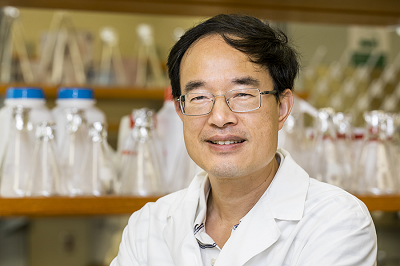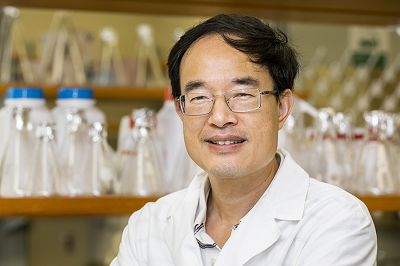The cutting edge


October 2018
Moving translational research forward: Noted scientist joins College of Medicine Faculty
Award-winning biological chemist Zucai Suo, whose discoveries helped the development of two blockbuster antiviral drugs, has joined the Florida State University College of Medicine as the Dorian and John Blackmon Endowed Chair in Translational Research.
His laboratory’s new ground-floor home at the medical school marks a figurative and literal expansion of the college’s research aspirations.
“He’s an emerging star in his field who will complement a number of our current faculty while also bringing significant new technology and ideas to our program,” said Jeffrey Joyce, senior associate dean for research and graduate programs. “His arrival fits our strategy to develop novel platforms for translational research. One of the things he’ll do is help us collaborate across many research strengths in other colleges at FSU to be successful.”
Suo focuses his research in three areas: the kinetic mechanisms of enzymes involved in DNA/RNA replication, lesion bypass and repair; understanding gene-editing enzymes; and developing small or large molecules as antiviral and anticancer drugs.
Earlier in his career, he helped the development of two small molecules leading to an HIV treatment that has generated more than $48 billion in revenue for the biotech giant Gilead Sciences, and an anti-hepatitis C drug that has generated about $5 billion for the biotech firm Vertex.
A near-term goal is the development of an FSU Drug Discovery Institute. “It is one of my dreams,” he said. “Hopefully, we can make the next big discovery here.”
Suo, who became a senior biochemist at Eli Lilly and Co. after completing a postdoctoral fellowship at Harvard Medical School, spent 17 years at The Ohio State University prior to his arrival at Florida State. At Ohio State, he won numerous teaching and research awards – including the 2005 National Science Foundation Career Award and becoming a 2013 elected fellow of the American Association for the Advancement of Science. Along the way he developed an international reputation for discoveries in antiviral and anticancer therapeutics.
Among his reasons for relocating to Florida State, Suo cites his new colleagues and the supportive atmosphere in the medical school’s Department of Biomedical Sciences; the university’s Institute of Molecular Biophysics, which presents additional opportunities to observe high-resolution structures of important biological complexes with bound drug molecules; and Florida cuisine.
“Tallahassee is a medium-size city and will be a great place for my family,” he said. “We’re so close to the Gulf of Mexico and there will be plenty of things to do during our leisure time. Yes, I’m also looking forward to experiencing the fresh seafood as well.”
Seeking to fill a new senior-level position in the broad arena of translational research in the biomedical sciences, an FSU search committee quickly became enamored of Suo. The committee was interested in identifying a candidate who fit the description of a preeminent faculty member with accomplishments in drug discovery. Suo stood out.
“Dr. Suo is on the cutting edge of DNA technology,” said Gary Ostrander, vice president for research at Florida State University.
In February, he was part of a team to publish an article in the journal Nature explaining how DNA bases shape-shift – or alter their form – for a thousandth of a second. The alteration in form – known as tautomerization – sometimes leads DNA’s replication process to match the wrong base pairs into its double helix, serving as the cause of genetic changes that drive evolution, aging and diseases, including cancer.
The “Tautomerization Hypothesis” was first proposed by 1953 Nobel Prize winners James Watson and Francis Crick, but nobody had previously explained the mechanics of how the replication mistakes are made, until the paper published in February.
With the discovery, Suo and his collaborators opened the door to ways for exposing the mutations to the body’s own defense systems, and to drugs able to target what previously may have been hidden from view.
“We are the first ones to really have solid, experimental evidence to support the Watson-Crick hypothesis,” said Suo, who is bringing five federal grants with him to Florida State.
“Any living organism is supposed to correct that mutation when a pair is mismatched, but the tautomerization happens so fast that it can’t be recognized by the DNA repair mechanism. So they hide there, and we believe that’s at least one of the main mechanisms for disease-causing mutations to survive in the DNA.”
Suo has completed an array of research on DNA damage and repair mechanisms, enzymatic control, and targets for new pharmaceutical approaches, creating opportunities to discover novel platforms for cancer treatment.
Some of his recent breakthroughs, in fact, have literally been about the cutting edge.
CRISPR (Clustered Regularly Interspaced Short Palindromic Repeats) technology – described as a game-changing tool in biology and medicine – creates a way to change a cell’s DNA sequence to correct or eliminate mutations that might cause disease. Known as gene editing, it works through the action of a protein (Cas9) functioning like a molecular scalpel.
Gene editing is done in clinical trials already, but impediments stand in the way of such treatments becoming safe for humans. A major concern involves CRISPR causing off-target effects – where the editing snips unintended areas of a DNA sequence.
Suo recently contributed to discoveries that may lead to making the scalpel’s work more precise, an important step in unlocking CRISPR’s full potential.
At present, CRISPR technology may be used to edit DNA outside the body through gene matching by removing a mismatched base pair of DNA and replacing it with a matched base pair. The technique is also used in combination with immunotherapy to treat some cancer patients.
The likelihood of one day gaining FDA approval for CRISPR technology to be used in repairing cells within the body hinges on the ability to ensure accurate cuts when removing DNA mutations.
“This is one of the major areas of my lab,” Suo said. “We are looking at the mechanism for DNA cutting and repair.”
While CRISPR technology has created enormous potential for modifying genes and removing mutations, there are many unsolved mysteries about how the tool edits DNA. In particular, scientists are seeking answers about how CRISPR-associated protein 9 (Cas9) binds and cuts a DNA strand.
For CRISPR to one day be used in the clinic for correcting genetic mutations and treating disease, more needs to be known about how these molecular scissors work.
Suo and his team generated a significant buzz in the scientific community for their work published in the Nature article, as evidenced by being selected to highlight their findings for a spotlight article in the Sept. 13 edition of the Journal of the American Chemical Society. The spotlight shares Suo’s analysis of gaps in understanding Cas9’s biochemical workings – specifically, insights about underlying mechanisms of particular binding and cutting, and repair of cut DNA.
Suo’s research demonstrated – for the first time – that the ends of the DNA strands are uneven (heterogeneous), complicating the protein’s ability to make an accurate cut. With additional insight about how the enzyme biochemically interacts with DNA, Suo shines a light on opportunities to further develop CRISPR/Cas9 as a safe and effective therapeutic.
Only then would CRISPR technology reach its enormous potential for use in the clinical setting.

